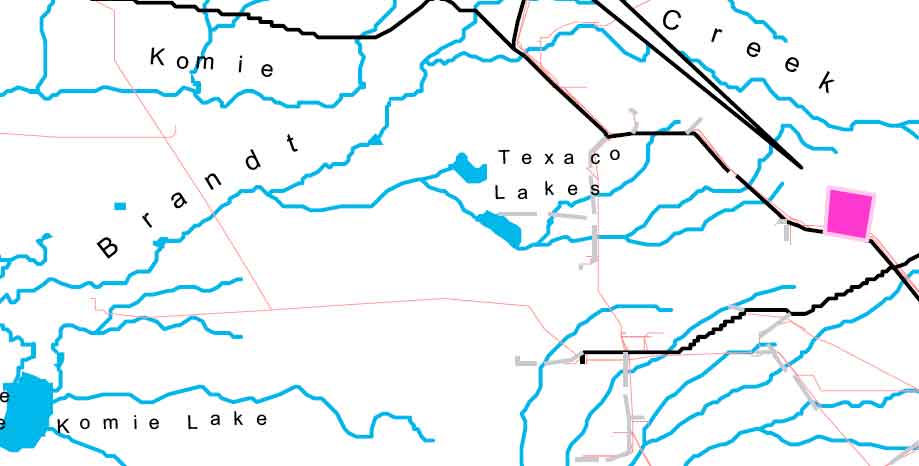
Location of the new plant (pink square),
next to "Texaco Lakes"
The one billion dollar (plus) plant proposal, initiated by Encana in December 2008, and reported on sporadically throughout 2009, received an Environmental Assessment Certificate, or provincial approval, a year later on January 18, 2010 from the BC Liberals, despite ongoing objections from the Fort Nelson area First Nation (Treaty 8) concerning cumulative environmental impacts. Oddly, the controversial proposal, located some 60 kilometers northeast of Ft. Nelson, received almost no formal public objections (only four public submissions to the BC Environmental Assessment Office), indicating that BC's public is fast asleep at the wheel.
The project will
process up to 800 million standard cubic feet per day of natural gas,
and be
located approximately 60 km northeast of Fort Nelson. The project will
be
constructed on one square km of provincial Crown land. The existing
EnCana Horn
River Pipeline will supply the raw gas to the project, and the
processed gas is
anticipated to be transported from the project to consumers by
TransCanada
Pipelines Limited’s proposed Horn River Mainline Project, currently
being
reviewed by the National Energy Board. (BC Gov't News Release)
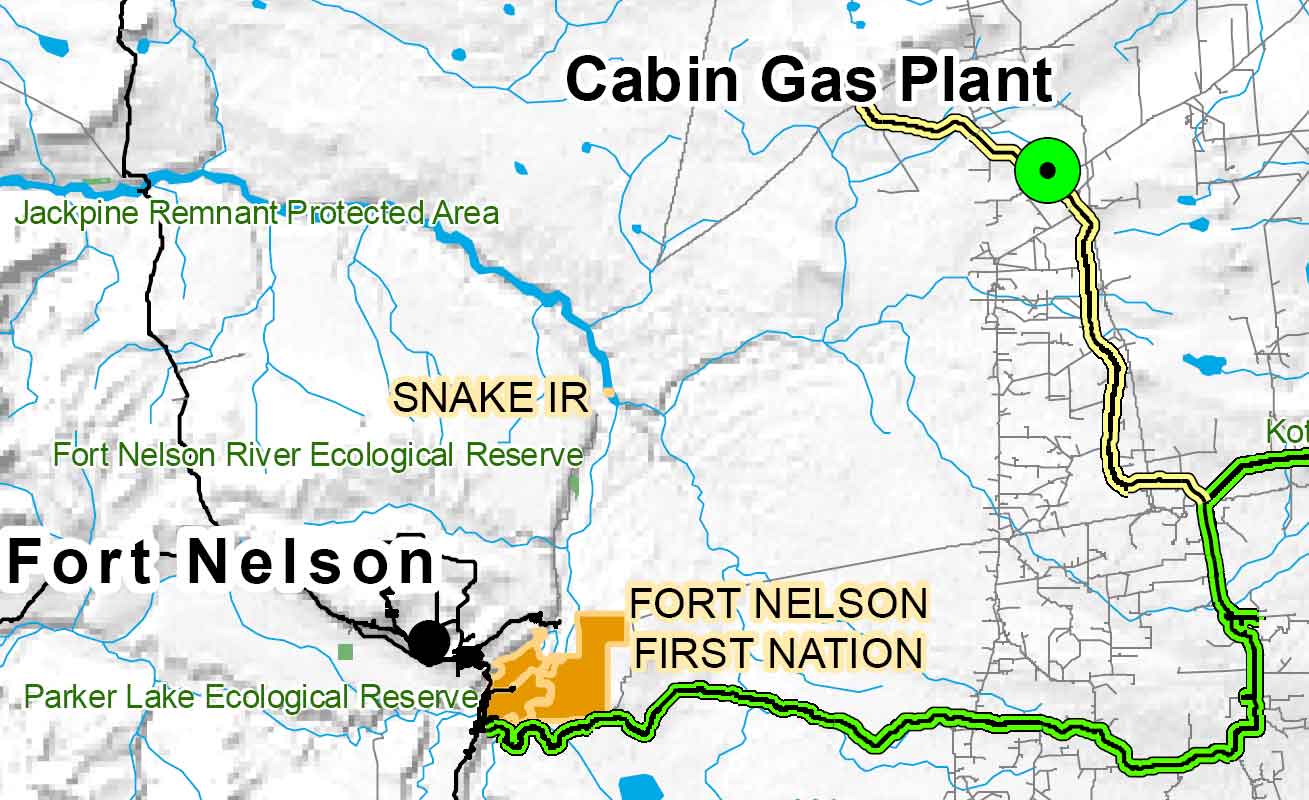
In addition to integrated and cumulative terrestrial environmental impacts associated with the wilderness-located, one-kilometer square plant, the atmospheric emissions or pollution emanating from Encana's Cabin Gas Plant are/is significant (the emissions, at 2.2. million annual tonnes of CO2, equivalent to some 450,000 vehicles per annum. Encana had 'promised' underground sequestration of emissions, which was subsequently dropped near the end of the Environmental Assessment process because of its "expense".).
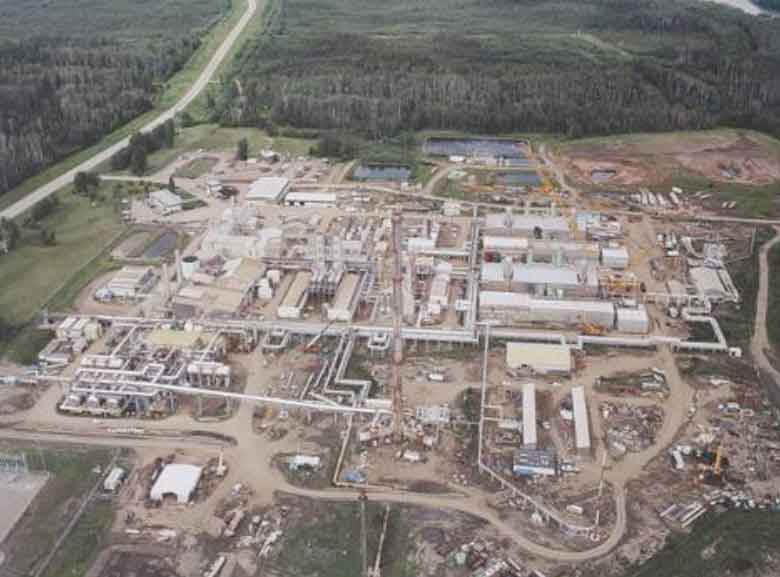
Spectra
Energy's
Natural
Gas
Plant,
near
Fort Nelson
When combined with Spectra Energy's gas plant in Fort Nelson, which is soon scheduled for expansion (proposed in August 2009), the emissions footprint is mega substantial (Spectra has 'promised' underground sequestration of emissions in all of its propaganda since 2008). A BC emissions footprint map from 2008 dramatically illustrates that about 40 percent of BC's total Green House Gas emissions are generated from this sector alone (Ft. St. John and Ft. Nelson areas - combined).
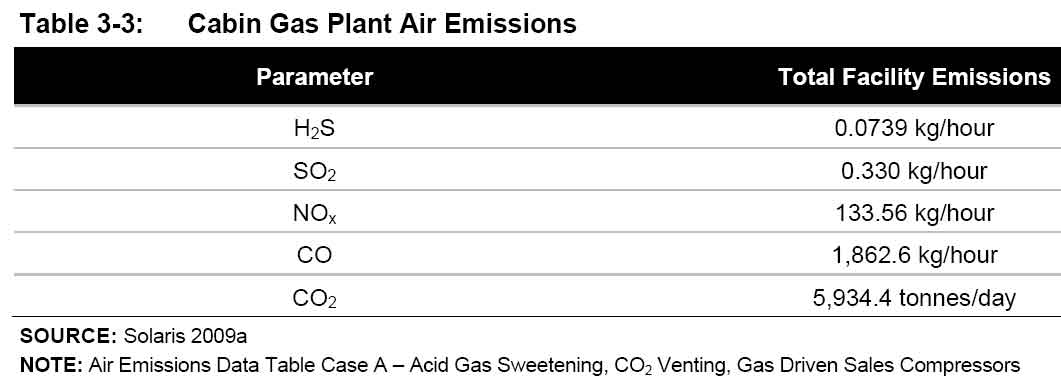
It is a
proud moment for us all when the premier declares his passion for
carbon reduction and aboriginal rights. But if he's saying that while
he's railroading a first nation in order to construct a massive
greenhouse gas emitter, that's worse than hypocrisy. It's a reminder
that in all these decades, nothing has changed -- that protecting the
environment and working with first nations are to be done only when
it's convenient for the B.C. government. (Fort
Nelson
First
Nation
Chief
Kathie
Dickie,
Vancouver Sun, December 29,
2009)
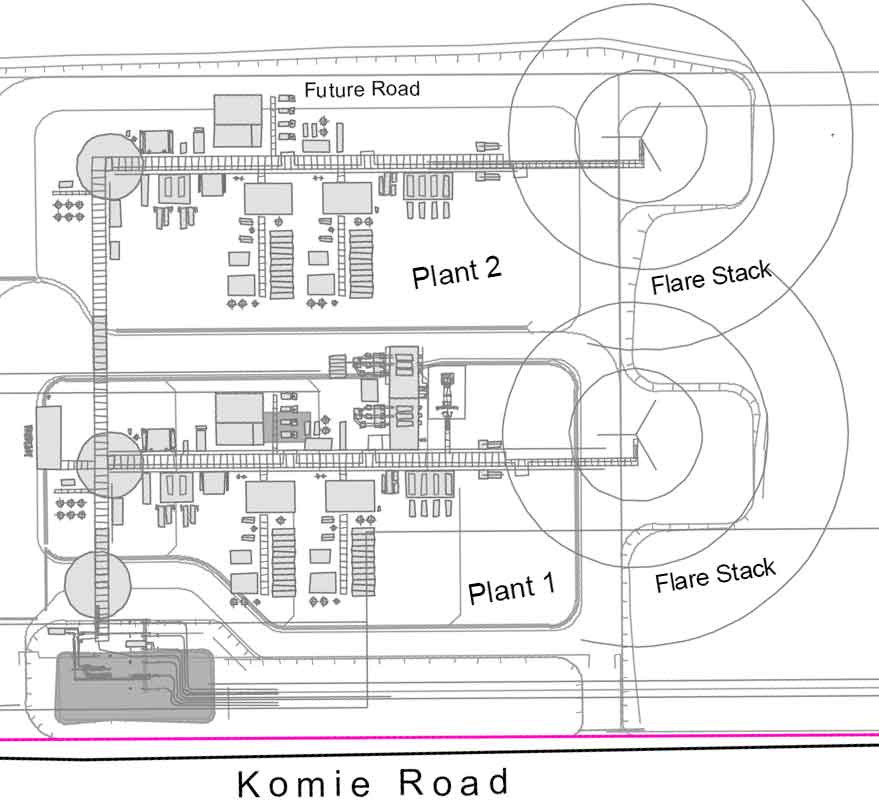
Encana
Cabin Gas Plant diagram
 (B.C.
Premier Gordon Campbell receiving a
(B.C.
Premier Gordon Campbell receiving a " climate action leadership " award from Tseporah Berman (PowerUP Canada) in Copenhagen, December, 2009. The award was co-sponsored by some top environmental NGOs. After this award was presented, news reporters quoted from a new report that B.C. was "the only province in Canada with rising greenhouse-gas emissions from industrial polluters.... B.C. belched up more than 13 million tonnes of industrial greenhouse gases last year, the first year of the celebrated carbon tax." )
Most of the increased natural gas production scheduled from both plants via the escalated increase in gas exploration (through 'fracking') in neighbouring shale plays is for export to the United States, and perhaps some scheduled to newly designed markets across the Pacific Ocean through Kitimat (LNG export).
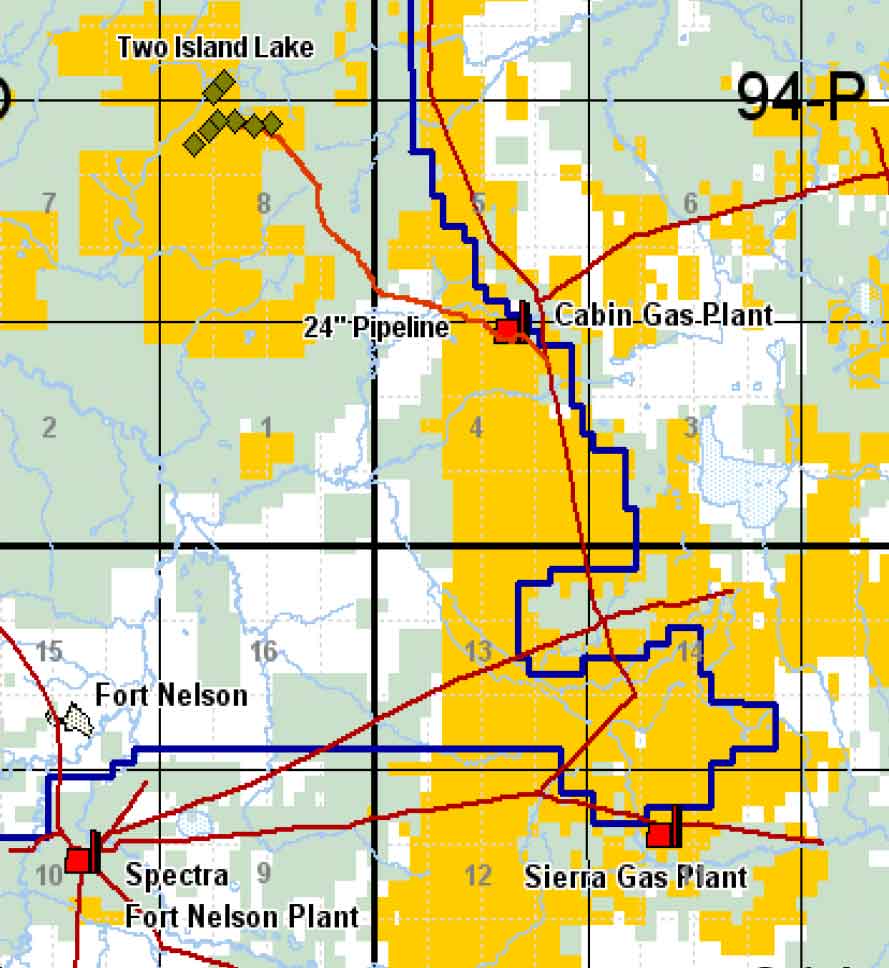
On March 28, 2010, Robert Howarth, the David R. Atkinson Professor of Ecology & Environmental Biology at Cornell University, wrote the following article, Gas and drilling not clean choices - Environmental risks too great; alternative fuels a better option:
Natural
gas is marketed
as a clean fuel with less impact on global
warming than oil or coal, a transitional fuel to replace other fossil
fuels until some distant future with renewable energy. Some argue that
we have an obligation to develop Marcellus Shale gas, despite
environmental concerns. I strongly disagree.
Natural gas as a clean fuel is a myth. While less carbon dioxide is emitted from burning natural gas than oil or coal, emissions during combustion are only part of the concern. Natural gas is mostly methane, a greenhouse gas with 72 times more potential than carbon dioxide to warm our planet (per molecule, averaged over the 20 years following emission). I estimate that extraction, transport and combustion of Marcellus gas - together with leakage of methane - makes this gas at least 60 percent more damaging for greenhouse warming than crude oil and similar in impact to coal.
The most recent method of hydro-fracking is relatively new technology, massive in scope and far from clean in ways beyond greenhouse gas emissions. The landscape could be dotted with thousands of drilling pads, spaced as closely as one every 40 acres. Compacted gravel would cover three to five acres for each. New pipelines and access roads crisscrossing the landscape would connect the pads. Ten or more wells per pad are expected. Every time a well is "fracked," 1,200 truck trips will carry the needed water.
Drillers will inject several million gallons of water and tens of thousands of pounds of chemicals into each well. Some of this mixture will stay deep in the shale, but cumulatively, billions of gallons of waste fluids will surface. Under current law, drillers can use absolutely any chemical additive or waste, with no restrictions and no disclosure. Recent experience in Pennsylvania indicates regular use of toxic, mutagenic and carcinogenic substances. Out of 24 wells sampled there, flow-back wastes from every one contained high levels of 4-Nitroquinoline-1-oxide, (according to the New York Department of Environmental Conservation). It is one of the most mutagenic compounds known. Flow-back wastes also contain toxic metals and high levels of radioactivity extracted from the shale, in addition to the materials used by drillers.
Industry tells us that surface and groundwater contamination is unlikely, since gas is deep in the ground and drilling operations are designed to minimize leakage. Nonsense. The technology is new and understudied, but early evidence shows high levels of contamination in some drinking water wells and rivers in other states.
Accidents happen, and well casings and cementing can fail. The geology of our region is complex, and water and materials under high pressure can move quickly to aquifers, rivers and lakes along fissures and fractures. Flow-back waters and associated chemical and radioactive wastes must be handled and stored at the surface, some in open pits and ponds unless government regulation prevents this. What will keep birds and wildlife away from it? What happens downstream if a heavy rain causes the toxic soup to overflow the dam? What happens to these wastes? Adequate treatment technologies and facilities do not exist.
What about government regulation and oversight? The DEC is understaffed, underfunded and has no history with the scale and scope of exploitation now envisioned. Federal oversight is almost completely gone, due to Congress exempting gas development from most environmental laws, including the Safe Drinking Water Act, in 2005.
We can be independent of fossil fuels within 20 years and rely on renewable green technologies, such as wind and solar. The constraints on this are mostly political, not technical. We do not need to sacrifice a healthy environment to industrial gas development. Rather, we need to mobilize and have our region provide some badly needed national leadership toward a sustainable energy future.
Natural gas as a clean fuel is a myth. While less carbon dioxide is emitted from burning natural gas than oil or coal, emissions during combustion are only part of the concern. Natural gas is mostly methane, a greenhouse gas with 72 times more potential than carbon dioxide to warm our planet (per molecule, averaged over the 20 years following emission). I estimate that extraction, transport and combustion of Marcellus gas - together with leakage of methane - makes this gas at least 60 percent more damaging for greenhouse warming than crude oil and similar in impact to coal.
The most recent method of hydro-fracking is relatively new technology, massive in scope and far from clean in ways beyond greenhouse gas emissions. The landscape could be dotted with thousands of drilling pads, spaced as closely as one every 40 acres. Compacted gravel would cover three to five acres for each. New pipelines and access roads crisscrossing the landscape would connect the pads. Ten or more wells per pad are expected. Every time a well is "fracked," 1,200 truck trips will carry the needed water.
Drillers will inject several million gallons of water and tens of thousands of pounds of chemicals into each well. Some of this mixture will stay deep in the shale, but cumulatively, billions of gallons of waste fluids will surface. Under current law, drillers can use absolutely any chemical additive or waste, with no restrictions and no disclosure. Recent experience in Pennsylvania indicates regular use of toxic, mutagenic and carcinogenic substances. Out of 24 wells sampled there, flow-back wastes from every one contained high levels of 4-Nitroquinoline-1-oxide, (according to the New York Department of Environmental Conservation). It is one of the most mutagenic compounds known. Flow-back wastes also contain toxic metals and high levels of radioactivity extracted from the shale, in addition to the materials used by drillers.
Industry tells us that surface and groundwater contamination is unlikely, since gas is deep in the ground and drilling operations are designed to minimize leakage. Nonsense. The technology is new and understudied, but early evidence shows high levels of contamination in some drinking water wells and rivers in other states.
Accidents happen, and well casings and cementing can fail. The geology of our region is complex, and water and materials under high pressure can move quickly to aquifers, rivers and lakes along fissures and fractures. Flow-back waters and associated chemical and radioactive wastes must be handled and stored at the surface, some in open pits and ponds unless government regulation prevents this. What will keep birds and wildlife away from it? What happens downstream if a heavy rain causes the toxic soup to overflow the dam? What happens to these wastes? Adequate treatment technologies and facilities do not exist.
What about government regulation and oversight? The DEC is understaffed, underfunded and has no history with the scale and scope of exploitation now envisioned. Federal oversight is almost completely gone, due to Congress exempting gas development from most environmental laws, including the Safe Drinking Water Act, in 2005.
We can be independent of fossil fuels within 20 years and rely on renewable green technologies, such as wind and solar. The constraints on this are mostly political, not technical. We do not need to sacrifice a healthy environment to industrial gas development. Rather, we need to mobilize and have our region provide some badly needed national leadership toward a sustainable energy future.
F. Sherwood Rowland, at the University of Califorinia Irvine, who holds a Nobel Laureate in Chemistry, wrote a report in August 2003, Extensive Regional Atmospheric Hydrocarbon Pollution in the Southwestern United States, concerning industrial emissions from Texas, Oklahoma and Kansas oil and natural gas production:
Light alkane hydrocarbons
are present in major quantities in the near-surface atmosphere of
Texas, Oklahoma, and Kansas during both autumn and spring seasons....
The elevated alkane mixing ratios are attributed to emissions from the
oil and natural gas industry. Measured alkyl nitrate mixing ratios were
comparable to urban smog values, indicating active photochemistry in
the presence of nitrogen oxides, and therefore with abundant formation
of tropospheric ozone. We estimate that 4–6 teragrams of methane are
released annually within the region and represents a
significant fraction of the estimated total U.S. emissions. This result
suggests that total U.S. natural gas emissions may have been
underestimated. Annual ethane emissions from the study region
are estimated to be 0.3–0.5 teragrams.
We have performed two regional studies in different seasons of hydrocarbon and halocarbon mixing ratios in surface-level air sampled within the southwestern United States. Elevated atmospheric mixing ratios of C1-C4 alkanes and C2-C4 alkyl nitrates (RONO2) were measured over much of the region during both studies. The alkyl nitrate enhancements show that significant photochemistry analogous to urban smog formation is occurring within the source region. The release of hydrocarbons into the atmosphere contributes to photochemical ozone (O3) production, with related adverse health effects, reduction in plant growth, and climate change. The production, storage, and transport of oil and natural gas are a major global source of hydrocarbons into the atmosphere, and the southwestern states have some of the largest oil and natural gas reserves in the United States. Although the U.S. natural gas industry has been estimated to account for ≈20% of the total U.S. anthropogenic methane (CH4) emissions, the global budgets of light (C2-C4) alkanes, including their emissions from the oil and natural gas industry, are more poorly assessed.
We have performed two regional studies in different seasons of hydrocarbon and halocarbon mixing ratios in surface-level air sampled within the southwestern United States. Elevated atmospheric mixing ratios of C1-C4 alkanes and C2-C4 alkyl nitrates (RONO2) were measured over much of the region during both studies. The alkyl nitrate enhancements show that significant photochemistry analogous to urban smog formation is occurring within the source region. The release of hydrocarbons into the atmosphere contributes to photochemical ozone (O3) production, with related adverse health effects, reduction in plant growth, and climate change. The production, storage, and transport of oil and natural gas are a major global source of hydrocarbons into the atmosphere, and the southwestern states have some of the largest oil and natural gas reserves in the United States. Although the U.S. natural gas industry has been estimated to account for ≈20% of the total U.S. anthropogenic methane (CH4) emissions, the global budgets of light (C2-C4) alkanes, including their emissions from the oil and natural gas industry, are more poorly assessed.
For the September
2001 study, the highest C2-C4 alkane mixing ratios were found in
western Texas.... Other local maxima were found in central
Oklahoma and southwestern Kansas.... The goals of the second
study of the southwestern U.S. (April–May 2002) were to determine the
concentrations of light alkanes in a different season, the full extent
of the area over which they are enhanced, and the source of the
enhancements.... The spring 2002 data again showed alkane hotspots in
Texas, Oklahoma, and Kansas. By comparison, much lower concentrations
of the light alkanes were observed to the west in New Mexico.... The
methane
concentrations show a pattern of enhancement.
By comparison to the calculated 4–6 Tg of CH4 released annually from the study area, global natural gas drilling has been estimated to release 45 Tg of CH4 per year, of which the U.S. natural gas industry alone has been credited with 6 ± 2 Tg of CH4 per year. These results show that the southwestern states account for a significant portion of U.S. CH4 release from natural gas sources. Because only 37% of the U.S. natural gas industry is located in Texas, Oklahoma, and Kansas, with another 25% offshore in the Gulf of Mexico, our results suggest that the actual CH4 emissions from the fossil fuel industries may be larger than currently estimated. Using similar conditions to the CH4 calculations, an emission rate of 0.3–0.5 Tg per year is calculated for ethane. By comparison, global natural gas emissions are believed to release 6 Tg of ethane yr–1 out of a global ethane budget of 13–15.5 Tg per year.
In this study, the elevated light alkane levels were measured within a region that encompasses the Anadarko Basin, which contains one of the largest natural gas and oil reserves in the continental U.S. Whereas individual sources of alkane emissions from this region (e.g., natural gas and/or oil production, natural gas storage, and perhaps natural gas seepage from the ground) are poorly quantified, sampling this region in a grid configuration was very effective in identifying locations with elevated alkane mixing ratios. Similar studies of natural gas and oil regions in other countries would help to constrain global emission estimates for methane and other light alkanes.
By comparison to the calculated 4–6 Tg of CH4 released annually from the study area, global natural gas drilling has been estimated to release 45 Tg of CH4 per year, of which the U.S. natural gas industry alone has been credited with 6 ± 2 Tg of CH4 per year. These results show that the southwestern states account for a significant portion of U.S. CH4 release from natural gas sources. Because only 37% of the U.S. natural gas industry is located in Texas, Oklahoma, and Kansas, with another 25% offshore in the Gulf of Mexico, our results suggest that the actual CH4 emissions from the fossil fuel industries may be larger than currently estimated. Using similar conditions to the CH4 calculations, an emission rate of 0.3–0.5 Tg per year is calculated for ethane. By comparison, global natural gas emissions are believed to release 6 Tg of ethane yr–1 out of a global ethane budget of 13–15.5 Tg per year.
In this study, the elevated light alkane levels were measured within a region that encompasses the Anadarko Basin, which contains one of the largest natural gas and oil reserves in the continental U.S. Whereas individual sources of alkane emissions from this region (e.g., natural gas and/or oil production, natural gas storage, and perhaps natural gas seepage from the ground) are poorly quantified, sampling this region in a grid configuration was very effective in identifying locations with elevated alkane mixing ratios. Similar studies of natural gas and oil regions in other countries would help to constrain global emission estimates for methane and other light alkanes.
| Main Fracking Page |
| INFORMATIONAL RESOURCES |
| BC Environmental Assessment Office |
| MAPS |
| News Stories |
| GHG Gas Emissions |
| Who or What is Encana and Spectra Energy? |